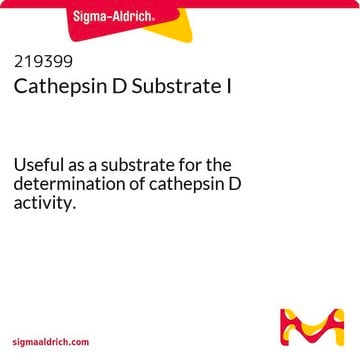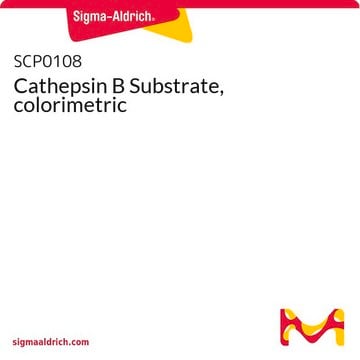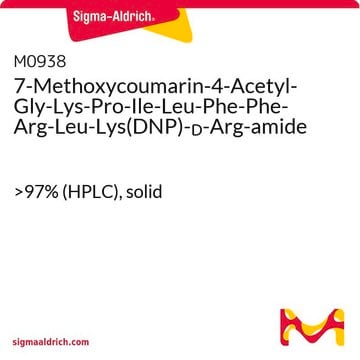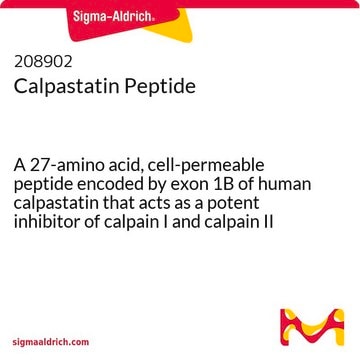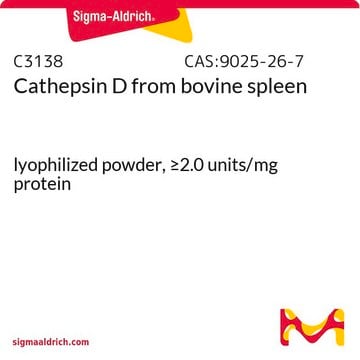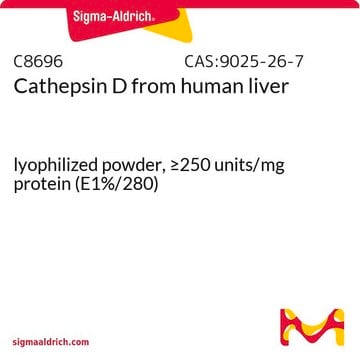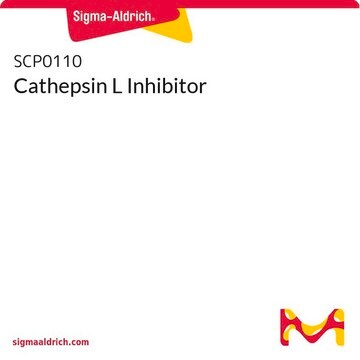SCP0109
Cathepsin D Substrate
≥95% (HPLC), lyophilized
Se connecterpour consulter vos tarifs contractuels et ceux de votre entreprise/organisme
About This Item
Formule empirique (notation de Hill):
C49H55N9O7
Poids moléculaire :
882.02
Code UNSPSC :
12352202
Nomenclature NACRES :
NA.32
Produits recommandés
product name
Cathepsin D Substrate,
Pureté
≥95% (HPLC)
Forme
lyophilized
Composition
Peptide Content, ≥85%
Conditions de stockage
protect from light
Température de stockage
−20°C
Amino Acid Sequence
Bz-Arg-Gly-Phe-Phe-Pro-4M2NA
Description générale
Cathepsin D Substrate is a peptide with Bz-Arg-Gly-Phe-Phe-Pro-4M2NA sequence.
Application
Cathepsin D Substrate has been used in cathepsin D enzymatic assays with Dictyostelium, midgut samples of beetles Stromatium fulvum (Villers) and of P. versicolora.
Code de la classe de stockage
11 - Combustible Solids
Classe de danger pour l'eau (WGK)
WGK 3
Point d'éclair (°F)
Not applicable
Point d'éclair (°C)
Not applicable
Certificats d'analyse (COA)
Recherchez un Certificats d'analyse (COA) en saisissant le numéro de lot du produit. Les numéros de lot figurent sur l'étiquette du produit après les mots "Lot" ou "Batch".
Déjà en possession de ce produit ?
Retrouvez la documentation relative aux produits que vous avez récemment achetés dans la Bibliothèque de documents.
Les clients ont également consulté
Proteolytic activity in Plagiodera versicolora Laicharting (Coleoptera: Chrysomelidae): Characterization of digestive proteases and effect of host plants
Zibaee A and Hajizadeh J
Journal of Asia-Pacific Entomology, 16, 329-334 (2013)
Digestive proteolytic profile in Stromatium fulvum Villers (Coleoptera: Cerambycidae)
ZIBAEE A, et al.
Romanian Journal of Biochemistry, 51, 17-30 (2014)
Robert J Huber et al.
Cellular signalling, 58, 79-90 (2019-02-17)
Mutations in CLN3 cause a juvenile form of neuronal ceroid lipofuscinosis (NCL). This devastating neurological disorder, commonly known as Batten disease, is currently untreatable due to a lack of understanding of the physiological role of the protein. Recently, work in
Hong-Ye Wan et al.
Advanced science (Weinheim, Baden-Wurttemberg, Germany), 5(3), 1700585-1700585 (2018-03-30)
Targeting protein degradation is recognized as a valid approach to cancer therapy. The ubiquitin-proteasome system (UPS) and the autophagy-lysosome pathway are two major pathways for intracellular protein degradation. Proteasome inhibitors such as bortezomib are clinically approved for treating malignancies, but
Tonyia Eaves-Pyles et al.
PloS one, 6(9), e24869-e24869 (2011-09-29)
Bacteria release flagellin that elicits innate responses via Toll-like receptor 5 (TLR5). Here, we investigated the fate of apically administrated full length flagellin from virulent and avirulent bacteria, along with truncated recombinant flagellin proteins in intestinal epithelial cells and cellular
Notre équipe de scientifiques dispose d'une expérience dans tous les secteurs de la recherche, notamment en sciences de la vie, science des matériaux, synthèse chimique, chromatographie, analyse et dans de nombreux autres domaines..
Contacter notre Service technique